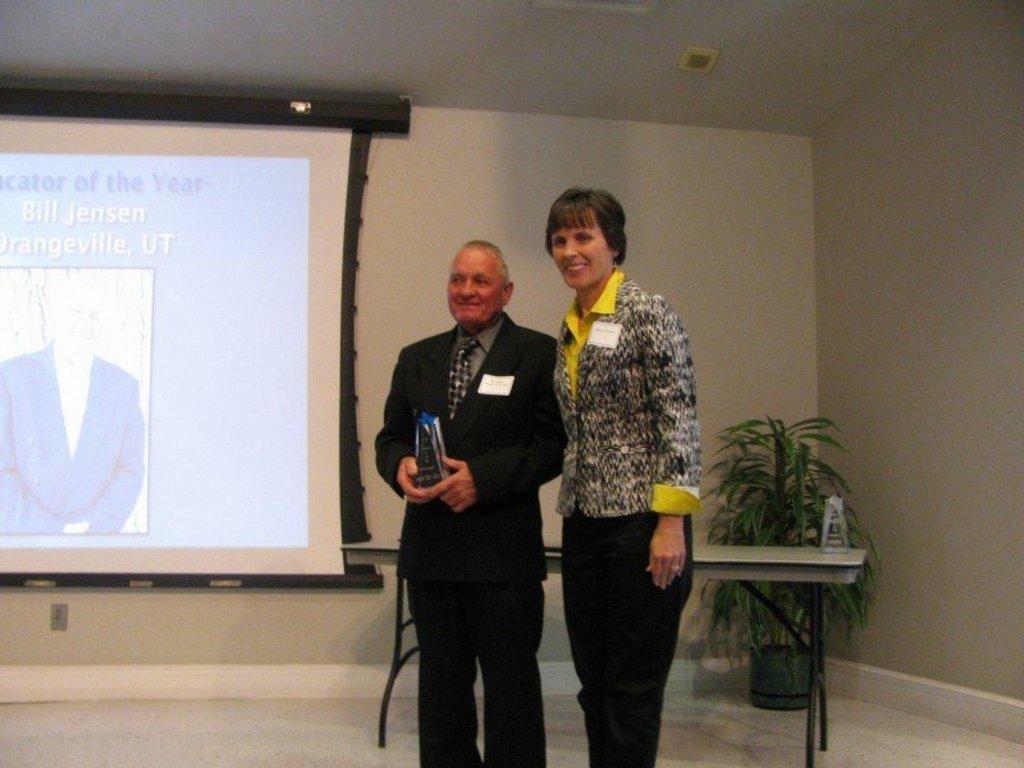By Sara Price
Willis “Bill” Jensen never expected to win awards when he began teaching special education 42 years ago. After a year of feeling like a policeman teaching regular kids, he moved over to special education at Castle Valley Center. In those days severely mentally handicapped children were labeled according to their IQ. If their IQ fell in the 40 and 50 range they were labeled “trainable mentally retarded children” and if their IQ was 60-80 they were considered “educable”. Most of Jensen’s students have been in the 40 -59 range.
Two years before Jensen began his career, John F. Kennedy announced that all children had the right to a “free and equal education.” This put the onus on local school districts to start teaching children that had been formerly hidden from society whether in an institution or in the home. When the children came, educators and school districts alike did not know what to do with them.
Jensen described his guidelines as more of a babysitting program. They would play games, do crafts, teach self help skills such as personal hygiene, but had nothing in the way of education materials and supplies. The education goals were modest. Teach the kids in the program as many as the 50 survival words as possible such as “man, woman, restroom” and to read and write their name and count to ten. No one at the time thought these kids were capable of anything more.
Two years after Jensen had started teaching, a new education program began making waves. It was called DISTAR. This program had been developed for at risk children who struggled with standard education programs designed for middle class youth. With DISTAR, educators taught two-year-olds how to read. Special education teachers thought that if DISTAR could teach two- year-olds to read, it could certainly teach their students at a mental age of five-years-old to read too.
Jensen proposed to the school district that if he had the DISTAR program, he could teach his students to read, but at the cost of $350. The school district was unwilling to part with funding for a program that had never been used in special education. So Jensen and his three aids checked out the program from South Eastern Media Center and put it to the test.
Jensen was working on a ground breaking change that would help shape the future of special education. The results were astounding. The students learned how to read, some thousands of words. Along with the reading advances, students improved in speech as well. The school district was convinced and bought the program for the next year.
Despite the student’s progress, there were still many who were convinced the feat Jensen was performing with the children was still impossible. Some felt that the skills demonstrated were often due to the fact that the children had been misdiagnosed. Others felt that it was pointless because the children could not comprehend, so what was the point of teaching them to read.
Because of his accomplishments, Jensen won his first educator award in 1990 as a Rural Special Educator, awarded by the Southwest Education Development Center.
As part of his teaching responsibilities, Jensen also served as a school bus driver. Carbon and Emery counties had combined the program for these severely challenged kids in order to pool funding to support a better program. This amounted to Jensen picking up the kids in Emery, driving them to Carbon, teaching them, and then driving them home. The days were long with the educator putting in twelve hours a day. This arrangement lasted for 35 years. Along with that, Jensen became a Behavior Modification Master and geared down the programs to suit the children he was teaching.
Jensen described his experience as incredible. “I feel that Castle Valley Center is a special place filled with exceptional people,” explained Jensen. “The staff appreciates all of the students efforts and the children work hard to learn. The parents for the most part are also happy with the school and engaged in the education of their children.”
Some of the biggest challenges from students are from those who become violent when upset. Due to the low mental age but large bodies, the children throw temper tantrums, scream, bite, spit and more. Many of the students wear diapers and can do little for themselves. “The most advanced student only had a mental capacity of a 12-year-old by the time they hit adulthood,” Jensen explained. “Most students end up with a mental age around five, with many coming in at a toddler’s mentality.” Jensen would not change his time with the students for anything.
With Jensen’s guidance, students who would have never been taught, can read at third to fourth grade levels with their comprehension making up about half that. This has opened their world and given them possibilities they would not have otherwise. Attitudes and understanding have evolved with the program, some with Jensen’s help.
On Sept.10, Jensen received his second award as Educator of the Year. This was presented by the Utah Developmental Disability Council. Jensen feels lucky to have received two awards, both of which were well deserved.
Jensen’s passion and willingness to push boundaries to fight for an education for challenged students, helped build the special education program into what it is today.
Castle Valley Center continues to serve moderately and severely mentally handicapped students starting at age three all the way up to age 22. Once old enough, the students are switched over to an adult program also offered the school. Castle Valley Center provides students with certified special educators, speech, occupational and physical therapists.


